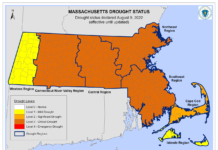BOSTON — With periodic precipitation events occurring throughout the Commonwealth in recent weeks, drought conditions, with the exception of groundwater in certain regions, improved or remained steady. As a result of recent data collections, Energy and Environmental Affairs (EEA) Secretary Kathleen Theoharides announced that the Southeast Region will be elevated to Level 1-Mild Drought, the Western and Cape Cod Regions will remain at a Level 1-Mild Drought, and Connecticut River Valley and Central Regions, which were previously declared at a Level 1-Mild Drought, will join the Northeast and Islands at a Level 0-Normal Conditions.
As outlined in the Massachusetts Drought Management Plan, a Level 1-Mild Drought warrants detailed monitoring of drought conditions, close coordination among state and federal agencies, and technical outreach and assistance to the affected municipalities.
“This summer, the Commonwealth’s drought monitor regions continue to experience fluctuations in conditions, which necessitates us all to take proactive water conservation steps to reduce the burden on our natural systems and public water supplies,” said Energy and Environmental Affairs Secretary Kathleen Theoharides. “With the growing season and high water usage recreation months officially starting, we strongly recommend that both residents and businesses limit outdoor water use to safeguard vital water systems.”
“While we’ve seen improvements in drought conditions in some regions, it’s important to be aware that the risk of brush and forest fires still exists,” said Massachusetts Emergency Management Agency (MEMA) Deputy Director Patrick Carnevale. “MEMA reminds residents to continue exercising caution when using charcoal grills, backyard fire pits, and other open flame outdoor activities and to call 911 if a fire starts to prevent it from spreading.”
Today’s declarations are the result of a recommendation issued by the state’s Drought Management Task Force, which is composed of state and federal officials, and other entities. Importantly, the task force will continue to meet once a month while regions of the state have been declared a Level 1-Mild Drought or higher, and will provide key recommendations to the EEA Secretary following an assessment of the previous month’s data.
Following a review of May data, it was determined that rainfall helped with recovery from deficits across much of the Commonwealth. Rainfall ranged from 5 to 6 inches (with some locations with higher totals), which was 1 to approximately 2 inches above normal. Lower rainfall totals of 3 to 5 inches were noted along far northern parts of Massachusetts and into the Berkshires, as well as the Outer Cape Cod and Nantucket area. In these locations, the rainfall was within an inch of normal.
Streamflow has also recovered across the state except for on Cape Cod, which is low due to being heavily influenced by groundwater levels. Groundwater recovery statewide was mixed. The Central and Northeast regions experienced the most recovery; the Western Region is still below normal; and groundwater levels in the Southeast and Cape Cod Regions continue to decline. The last few years of monitoring have indicated that the Southeast region in particular is experiencing far more fluctuations in hydrological conditions. Importantly, fire danger is in the normal range with minimized deep burning fire behavior.
To reduce water consumption, residents and businesses should consider:
- Limiting outdoor watering to no more than one day a week (before 9:00 am and after 5:00 pm)
- Planting non-lawn/non-grass landscapes;
- Increasing plantings of drought tolerant species and to shift to non-lawn/non-grass landscapes; and,
- Installing rain collection systems to help with watering of outdoor plants and vegetable gardens.
For more information, please visit EEA’s webpages on indoor and outdoor water use. Additionally, individuals are asked to follow any additional watering requirements outlined by their community’s Public Water Supplier. While water supplies are currently operating within suitable conditions, individuals are encouraged to also follow any supplementary watering requirements outlined by their community’s Public Water Supplier. Furthermore, the Massachusetts Water Resources Authority (MWRA) water supply system is not currently experiencing drought conditions, as defined within its individual plan.
Recommendations for regions in a Level 1-Mild Drought include:
Residents and Businesses:
- Limit outdoor watering to 1 day a week (only from 5:00PM – 9:00AM), or less frequently if required by your water supplier;
- Toilets, faucets and showers are more than 60% of indoor use. Make sure yours are WaterSense efficient; and,
- Switch to more drought-tolerant plants.
Short- and Medium-Term Steps for Communities:
- Establish a year-round water conservation program that includes public education and communication;
- Provide timely information to local residents and businesses;
- Check emergency inter-connections for water supply; and,
- Develop a local drought management plan.
The Massachusetts Department of Environmental Protection (MassDEP) also provides technical assistance to communities on managing systems, which includes assistance on the use of emergency connections and water supplies.
“With summer weather off to such a warm start, it is important for everyone to keep an eye on the drought status in their region and adhere to the water conservation requirements in their communities,” said MassDEP Commissioner Martin Suuberg. “It looks like it could be a hot, dry summer ahead. Conserving water now will be an advantage for our communities and our natural resources in the long run.”
The Drought Management Task Force will meet again on Wednesday, July 7, 2021 at 1:00 PM. Ongoing efforts include state agencies closely monitor and assess conditions across the Commonwealth, coordinate any needed dissemination of information to the public, and help state, federal and local agencies prepare additional responses that may be needed in the future. For further information on water conservation and what residents and communities can do, visit the Executive Office of Energy and Environmental Affairs’ drought page and water conservation pages.















